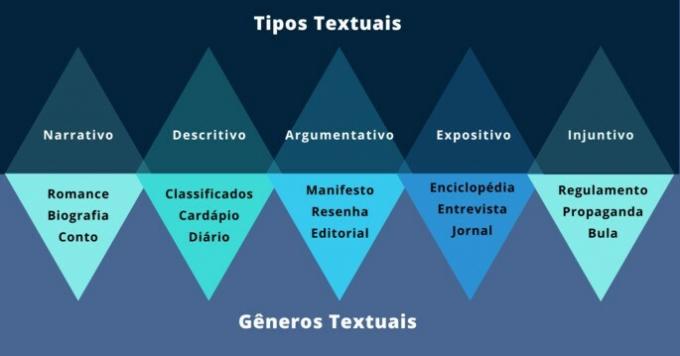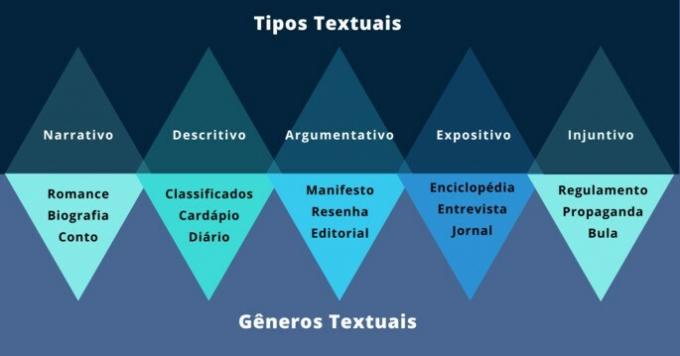textual genre is a set of oral and written texts socially recognized for their similar characteristics. These similarities occur in relation to the context of circulation, formal characteristics, structure, topic addressed and communicative intention.
Text genres classify texts according to their sociocommunicative functions. They consider, in addition to the linguistic structure, extralinguistic elements, such as, for example, the social function, the interlocutor and the context.
All text, i.e. every form of communication belongs to a textual genre. That's why they are countless: fables, short stories, recipes, notes, jokes, novels, medicine inserts, telephone messages, posts on social networks, scientific articles, etc.
Text genres are flexible and changeable structures, adapting to new communicative contexts. In the same way that some genres change and even disappear over time, new ones appear to meet new expression needs.
Relationship between Genres and Text Types
In addition to textual genres, there is another category for classifying texts: textual types.
Textual typology classifies texts according to their form., that is, how its structural linguistic elements (syntactic, lexical, sequential and compositional) are organized so that the text fulfills its communicative function.
Unlike genres, text types are fixed, immutable structures. There are five text types: narrative, descriptive, argumentative, injunctive and expository. Each of these types can contain several text genres. A narrative type text, for example, contains the genres romance, chronicle, joke, among others.
Text genres, on the other hand, due to their flexibility, can contain more than one text type, one of them being predominant. The chronicle genre, for example, contains elements of the narrative and argumentative types, but is predominantly narrative.
We can say, therefore, that while textual genres are more linked to the concreteness of communicative process, the textual typology is more related to the theoretical, more formal aspect of language.
Let's see below a little more about each of the five text types, with the main genres related to them.

Narrative text
To narrate is to tell a story. Soon, the narrative text is composed of stories. To be narrative, the text must present characters, a plot, a narrator or narrative focus, a space where the story unfolds, in a certain time interval.
Examples of predominantly narrative textual genres:
- Romance
- Novel
- Chronic
- Tale
- Biography
Descriptive Text
Descriptive texts, as the name suggests,write or report situations, places, things or people in detail. The descriptive text usually composes other textual types, especially the narrative. It is common to use adjectives in this textual type, aiming to convey to the receiver the sensations described by the sender.
Examples of predominantly descriptive textual genres:
- Menu
- trip report
- Daily
- tourist brochure
- Classified
Argumentative text
In argumentative texts the sender defends or criticizes a certain point of view through arguments. Its structure is similar to that of school dissertations, consisting of an introduction, development and conclusion.
Examples of predominantly argumentative textual genres:
- critical review
- journalistic editorial
- undersigned
- Manifest
- opinion letter
Expository Text
The expository text aims to introduce a subject or add information on a particular topic. Therefore, these texts usually present testimonies, dates, authorized research sources, statistical data, descriptions, comparisons, definitions, among others.
Examples of predominantly expository textual genres:
- dictionary entries
- Encyclopedia
- Seminar
- Newspaper
- Interview
Injunctive Text
Injunction means order, obligation, imposition. Soon, injunctive texts present orders or instructions to the receiver, trying to persuade or guide him. In this textual type, it is common to use verbs in the infinitive, which indicate command or request.
Examples of predominantly injunctive textual genres:
- Cooking recipe
- Instruction manual
- medicine leaflet
- Regulation
- Advertising
Bibliography:
- FAVERO, Leonor L.; KOCH, Ingedore. Textual Linguistics: introduction. São Paulo: Cortez, 2000.
- NASCIMENTO, Elvira Lopes [org.]. Textual genres: from didactics of languages to teaching objects. So Paulo: Claraluz, 2009.
See too:
- Examples of Text Genres
- text types
- Text meaning
- Narrative text
- Characteristics of narrative text
- news textual genre
- Daily textual genre
- 7 examples of opinion articles to understand this textual genre

